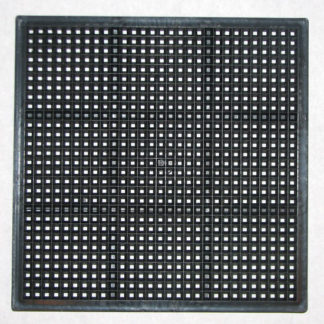Description
The Rounded Ceramic and Marble File is a smaller alternative to our regular marble file, and one side of the file is rounded. The other side is flat, and both sides have a rough carbide grit surface. The blade of the file is 5.25 inches long x 0.5 inches wide. This smaller size and the rounded side of the file makes the tool more useful for shaping smaller tiles on art projects.
When to Use This Tool
Smoothing Cuts
Cutting marble mosaic and ceramic tile often leaves rough, jagged, or sharp edges, and this tool can be used to smooth and round them. You can also do a modest amount of shaping with this tool, depending on how hard your material is. We have used this file on glass tile, but it has a tendency to pull flakes of glass out the edge being smoothed, especially if the motion of the tool is too fast or hard. To minimize this problem we only use the fine-grooved side on glass, and we pull the tile at a shallow angle on the stationary file and use limited pressure. Like most tools and techniques, a little practice can greatly improve your results.
A less aggressive alternative to a marble file is the dual-grit rubbing stone, which can be used to obtain smoother finishes on an edge and doesn’t chip off flakes of glass.
Repairing Damaged Tiling and Mosaics
Broken tile is dangerous not only because it can be razor sharp but also because it is often located on the corner or edge of a surface, just in the right location for people to brush against and cut themselves. The Ceramic and Marble File can be used to round off sharp edges.
Safety
Dust
Avoid breathing construction dusts of any type, especially glass, cement, ceramics, stone, etc. An ordinary dust mask rated N95 is recommended as a precaution when using the file, but we prefer to contain the dust with mist at the source. Keeping the dust wet is an easy was to make sure it stays out of the air. Dispose of the wet dust as solid waste in a trash bag and not down your drains.
We lean the file inside a 2-gallon bucket and mist with water from a spray bottle. The bucket collects the waste and acts as a moisture reservoir for keeping the air around the file humid, which causes dust to fall out of the air faster. Note that misting causes the file to rust and shortens the life of the tool, but files are more easily replaced than lungs, especially when you work with construction materials everyday.
Safety Glasses
Always wear safety glasses with side shields when using the file. Make sure that you don’t file tile around people not wearing safety glasses. Flying chips could potentially hit their eyes as easily as yours.
Slivers and Surfaces
Be aware that cutting and filing tile can produce tiny slivers that are surprisingly sharp. Never sweep off a work surface with your bare hand. This is how most cuts happen in the studio (seriously). Use a vacuum or counter brush instead.
How To Make Mosaics
For more advice on designing your mosaic project or mounting, cutting, and grouting tile, please see our page of Mosaic Frequently Asked Questions or our Mosaic Information Guide, which lists instructional pages described by topic. We also post new articles about making mosaics at our How to Mosaic Blog.



